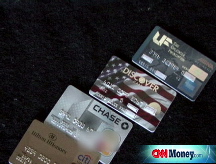Cheap money: The Fed rate cut and you
Yes, the federal funds rate is now at a record low, but that doesn't mean much to credit seekers.
NEW YORK (CNNMoney.com) -- The Federal Reserve may have cut its key short-term interest rate to the lowest level on record, but that doesn't mean credit will be any easier to get.
The move to lower the fed funds target rate to a range between 0% and 0.25%marked the tenth time the Fed has cut rates in the past 15 months in an attempt to jumpstart the economy.
Generally, the Fed lowers rates when it is concerned about the economy slowing because consumers tend to spend more when the cost of borrowing is cheap. But economists say the problem for consumers and businesses right now is not the cost of borrowing, but the availability of credit.
"Consumers might see lower rates but it's still hard to get a loan," said Gus Faucher, director of macroeconomics at Moody's Economy.com. "Banks are taking big hits, and they're still trying to preserve capital. So they'll only make loans if you're a good credit risk."
The federal funds rate is an overnight lending rate that is used as a benchmark to determine the price of a variety of loans, including credit cards, home equity loans, lines of credit and car loans.
Most types of consumer loans are pegged to the prime rate, which is directly influenced by the federal funds rate. Typically, the prime rate is 3 percentage points higher than the federal funds rate. It was 4% before Tuesday's rate cut; just after the decision, several banks announced they were lowering their prime rate to 3.25%.
In turn, all credit cards with variable interest rates will automatically reset to reflect the lower rate. That is good news for card holders, but expect issuers to counter it by setting rate floors in order to preserve their margins, as well as scaling back consumer credit lines and closing old accounts.
"Banks are trying to mitigate losses," said Robert McKinley, CEO of CardWeb.com, a credit card tracking Web site.
"New credit is going to be a problem," McKinley added. "If you have shaky credit you're going to be very challenged to find money...even people with good credit are going to find it's not as easy to get credit," he said.
And the same goes for consumers shopping for home equity lines of credit. "Lenders are not jumping up and down to be a second lien holder at a time when home prices are falling and foreclosures are rising," said Greg McBride, senior financial analyst at Bankrate.com.
Those in the market for a new car will certainly find deals, but that's mostly thanks to slashed sticker prices, not lower interest rates. That's because auto loans are not overly rate sensitive. For example, despite the Fed rate cuts, the average five-year note for a new car loan is at 7.05%, down from 7.60% a year ago.
"Rates have not gotten significantly lower, but even if they did it wouldn't have a significant impact on affordability," said McBride.
Plus, even if borrowers can get financing, the difference of a percentage point doesn't seriously impact affordability. "Nobody is upgrading to a Hummer based on lower interest rates," McBride added.
For many mortgage holders, the cumulative Fed rate cuts will result in lower payments when their variable-rate loans reset in 2009. But there is also a diluted effect: While this is a good time to refinance your existing mortgage, those in the market for a new home will need excellent credit to get a low rate.
"To obtain today's low interest rates, you need to have a down payment - or equity position in your home in the case of a refi - of at least 10% and fully document your income and your assets," said Keith Gumbinger, vice president of mortgage-rate tracking firm HSH Associates. "If you don't have good credit, you're going to have trouble getting financing."
"It used to be, you had to prove you were alive to get a mortgage," he added. ![]()


